| |
|
Xiamen Oil Paintings, Wholesale Direct!
|
|
100% hand painted, 100% cotton canvas, 100% money back if not satisfaction. |
|
|
|
|
ART WORKS INDEX
A
B
C
D
E
F
G
H
I
J
K
L
M
N
O
P
Q
R
S
T
U
V
W
X
Y
Z
|
|
ARTISTS INDEX
A
B
C
D
E
F
G
H
I
J
K
L
M
N
O
P
Q
R
S
T
U
V
W
X
Y
Z
|
|
|
|
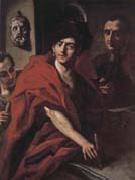 |
Cosmas Damian asam
|
|
1686-1739
Tegernsee, Bavaria died April 29, 1750, Mannheim, Palatinate) Bavarian architects and decorators. After studying in Rome (1711 C 13), Cosmas Damian became a prolific fresco painter, and his brother, Egid Quirin, became a sculptor and stuccoist. They developed the effects of dramatic lighting and illusionism originated by Gian Lorenzo Bernini and Andrea Pozzo. Working as a team, they produced magnificent illusionistic decoration in ecclesiastical buildings, combining dramatic lighting and colour. Their works are notable for their profound and dramatic intensity of religious feeling. The brothers became the principal late Baroque exponents of illusionist decoration in religious architecture. Their most notable collaboration is the church of St. John Nepomuk in Munich
|
|
|
|
 |
Cornelis van Dalem
|
|
1535-1576
Dutch
Cornelis van Dalem Location
Flemish painter. He was the son of a well-to-do cloth merchant living in Antwerp, but of Dutch origin. Cornelis received a humanistic education. His father, who owned land in Tholen, as a vassal to the Counts of Holland and Zeeland, was dean of the chamber of rhetorics De Olijftak (The Olive Branch) in Antwerp in 1552-3. According to van Mander, Cornelis was himself learned in poetry and history and only painted as an amateur, not for a living. Documents in the Antwerp archives invariably refer to him as a merchant, never as a painter, which no doubt accounts for the small number of known paintings by him. He learnt to paint with an otherwise unknown artist, Jan Adriaensens, who had also taught his older brother Lodewijk van Dalem ( fl 1544-85). The latter was inscribed as a pupil in 1544-5 and became a master in the guild in 1553-4. Cornelis was himself inscribed a year after his brother, and he became a master in 1556, the same year he married Beatrix van Liedekercke, a member of an Antwerp patrician family. They lived in Antwerp until late 1565, when, apparently for religious reasons, they left for Breda, together with the artist mother, who had become a widow in 1561. In 1571 several local witnesses testified that van Dalem, who was then living in a small castle, De Ypelaar, in Bavel, near Breda, was strongly suspected of being a heretic. He was never seen in church and was said, on the contrary, to have often attended Protestant services and to have publicly expressed contempt for Papists.
|
|
 |
Cornelis Dusart
|
|
1660-1704 Dutch
Dutch painter, draughtsman and printmaker. He was the son of the organist at St Bavo in Haarlem and one of the last pupils of Adriaen van Ostade. He became a member of the Haarlem Guild of St Luke on 10 January 1679 and served as its dean in 1692. Dated pictures by Dusart have survived from almost every year between 1679 and 1702. Two of his earliest pictures of peasants relied heavily on compositions by van Ostade: Mother and Child (1679; Dresden, Gemeldegal. Alte Meister) and Woman Selling Milk (1679; sold Amsterdam, Muller, 16 Oct 1928, lot 9; the original drawing by van Ostade is in Paris, Fond. Custodia, Inst. Neer., see Schnackenburg, 1981, no. 132).
|
|
 |
Cornelis de Wael
|
|
Cornelis de Wael (1592-1667) was a Flemish painter of the Baroque period, active mainly in Italy, specifically Genoa. He was born in Antwerp, the son of a painter, and died in Rome.
|
|
 |
Cornelis de Man
|
|
(Delft, 1 July 1621 - Delft, 1 September 1706) was a Dutch Golden Age painter.
Kornelis was not satisfied with life in Delft. He wanted to travel beyond the port of Dordrecht and that is what he did, spending a year in Paris as soon as he came of age and had enough talent to pay his way with his painting skills. He was well-received, but set off in the Spring for Lyon in order to cross Lombardia and the mountains before another winter set in. He settled for two years in Florence, where he had a rich patron, but stayed the longest in Rome. On the way back home he stopped in Venice, and in the end was gone for a total of nine years
|
|
 |
Cornelis de Heem
|
|
Dutch Baroque Era Painter, 1631-1695
Son of Jan Davidsz. de Heem. He spent a great deal of his life in Antwerp, where he was taught by his father. Cornelis also worked in Utrecht in 1667, in nearby IJsselstein in 1676 and in The Hague from 1676 for more than ten years. His best works approach the quality of his father, particularly in works executed during the decade starting in 1655. Cornelis still-lifes can be distinguished by daring colour harmonies, sometimes with a strong blue. His compositions are often simpler: fruit-pieces, floral bouquets, festoons and garlands and sumptuous still-lifes, only occasionally in large formats. His technique changed from a more painterly to a more graphic style.
|
|
|
|
 |
Constantin Daniel Stahi
|
|
(November 14, 1844 - June 18, 1920) was a Romanian painter and gravure artist.
In 1862 he entered the National School of Fine Arts from Iaşi where he was taught by Gheorghe Panaiteanu Bardasare and Gheorghe Şiller. He continued his artistic education in Munich where, for seven years, he studied painting, metal gravure and xylography.
He painted still life paintings representing small objects that were surrounding him, such as old books, newspapers, religious items, chairs, shoes, plates and especially fruits. Also, he painted many portraits of famous people of his time (for example Gheorghe Asachi, painted in 1881). Many others of his paintings take inspiration from the simple life in the countryside in idyllic compositions and by painting peasants having as models people living in Bavaria and Moldova regions.
Beside his artistic career, he was a professor and, later on, the headmaster of the National School of Fine Arts in Iaşi between 1892 and 1902, following Gheorghe Panaiteanu Bardasare.
He died in his house on Bărboi street in Iaşi on June 18, 1920 and was interred at Eternitatea Cemetery.
|
|
|
|
|
|
|
|
 |
Claude Deruet
|
|
(1588-1660) was a famous French Baroque painter of the 17th century, from the city of Nancy.
Deruet was an apprentice to Jacques Bellange, the official court painter to Charles III, Duke of Lorraine. He was in Rome between ca. 1612 and 1619, where - according to Andre Felibien - he studied with the painter and etcher Antonio Tempesta. During his stay in Rome, he painted the Japanese samurai Hasekura Tsunenaga on a visit to Europe in 1615.
Deruet was made a noble by the Duke of Lorraine in 1621, and was then made a Knight of the Order of St Michel in 1645 by Louis XIII, who had in 1641 absorbed most of Lorraine into France. He had a luxurious residence in Nancy, named La Romaine, where Louis XIII and his Queen stayed in 1633.
Claude Lorrain was an apprentice to Claude Deruet in 1623 for one year. He also married and had two sons, one of whom became a painter.
|
|
|
|
|
|
|
|
 |
CIMA da Conegliano
|
|
Italian Painter, ca.1459-1517
Italian painter. He belonged to the generation between Giovanni Bellini and Giorgione and was one of the leading painters of early Renaissance Venice. His major works, several of which are signed, are almost all church altarpieces, usually depicting the Virgin and Child enthroned with saints; he also produced a large number of smaller half-length Madonnas. His autograph paintings are executed with great sensitivity and consummate craftsmanship. Fundamental to his artistic formation was the style that Bellini had evolved by the 1470s and 1480s; other important influences were Antonello da Messina and Alvise Vivarini. Although Cima was always capable of modest innovation, his style did not undergo any radical alteration during a career of some 30 years, and his response to the growing taste for Giorgionesque works from the early 16th century remained superficial. He seems to have maintained a sizeable workshop,
|
|
|
|
 |
Christine de Pisan
|
|
French poet and arguably the first female author.
1364-1430
French writer. She was the daughter of an astrologer to Charles V and the wife of a court secretary and took up writing to support her children when she was widowed, producing 10 volumes of graceful verse, including ballads, rondeaux, lays, and complaints, many in the courtly-love tradition. Some works, both poetry and prose, champion women, notably The Book of the City of Ladies (1405).
|
|
 |
Christian Wilhelm Ernst Dietrich
|
|
German Painter, 1712-1774,German painter and etcher. He received his first training from his father, Johann Georg Dietrich (1684-1752), a court painter at Weimar, and was sent to Dresden at the age of 13 to study under the landscape painter Johann Alexander Thiele (1685-1752). In 1728 they travelled to Arnstadt to paint landscapes for stage sets. In 1730 Thiele presented his pupil to Frederick-Augustus I, Elector of Saxony, as a prodigy; Frederick-Augustus appointed him court painter and entrusted him to his minister Heinrich, Graf von Brehl, for whom he worked on some decorative paintings. From 1732 he used the name 'Dietricy' to sign his paintings. He travelled in Germany from 1734 and may have visited the Netherlands, the source of his artistic inspiration. He returned from his travels in 1741 and was appointed court painter to Frederick-Augustus II, Elector of Saxony, who sent him to Italy in 1743 to study. He visited Venice and Rome but returned to Dresden in 1744.
|
|
 |
Christian Daniel Rauch
|
|
1777 Arolsen-1857 Dresden,was a German sculptor. Rauch was born at Arolsen in the Principality of Waldeck. His parents were poor and unable to place him under efficient masters. His first instructor taught him little else than the art of sculpting gravestones, and Professor Ruhl of Kassel could not give him much more. A wider field of improvement opened up before him when he removed to Berlin in 1797; but he was obliged to earn a livelihood by becoming a royal lackey, and to practise his art in spare hours. Queen Louisa of Prussia, surprising him one day in the act of modeling her features in wax, sent him to study at the Academy of Art. Not long afterwards, in 1804, Count Sandrecky gave Rauch the means to complete his education at Rome, where Wilhelm von Humboldt, Antonio Canova and Bertel Thorvaldsen befriended him. Among other works, he executed bas-reliefs of "Hippolytus and Phaedra," "Mars and Venus wounded by Diomede," and a "Child praying." In 1811 Rauch was commissioned to execute a monument for Queen Louisa of Prussia.
|
|
 |
Christen Dalsgaard
|
|
(October 30, 1824-February 11, 1907), Danish painter, was born on the Krabbesholm estate on the fjord near Skive, and was son of the estate owner, Jens Dalsgaard.
|
|
|
|
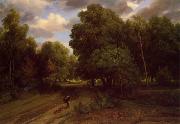 |
Charles-Francois Daubigny
|
|
French Barbizon School Painter, 1817-1878
was one of the painters of the Barbizon school, and is considered an important precursor of Impressionism. Daubigny was born into a family of painters and was taught the art by his father Edmond François Daubigny and his uncle, miniaturist Pierre Daubigny. Initially Daubigny painted in a traditional style, but this changed after 1843 when he settled in Barbizon to work outside in nature. Even more important was his meeting with Camille Corot in 1852 in Optevoz (Is??re). On his famous boat Botin, which he had turned into a studio, he painted along the Seine and Oise, often in the region around Auvers. From 1852 onward he came under the influence of Gustave Courbet. In 1866 Daubigny visited England, eventually returning because of the Franco-Prussian war in 1870. In London he met Claude Monet, and together they left for the Netherlands. Back in Auvers, he met Paul Cezanne, another important impressionist.
|
|
|
|
 |
Charles S. Dorion
|
|
Charles was most likely born in Quebec, Canada, and moved to New York City sometime after 1880. He had a publishing company called C.S. Dorion, and was the 8th company to publish Edgar Allan Poe's the Raven, in New York in 1881.
PoliticsDuring the 1890s, Charles Dorian socialized with New York City's Social Democratic Party's elite, and used his quick tongue and self appointed crusading against injustice to help propel his friends political careers.
His first noted case was in the summer of 1893, when bucket shops were becoming a rampant problem in the city, as these "bucket shops" specializing in stocks and commodity futures, as the terms of trade were different for each bucket shop.
|
|
 |
Charles Harold Davis
|
|
1856-1933
He was born at Amesbury, Massachusetts. A pupil of the schools of the Boston Museum of Fine Arts, he was sent to Paris in 1880. Having studied at the Acad??mie Julian under Jules Joseph Lefebvre and Gustave Boulanger, he went to Barbizon and painted much in the forest of Fontainebleau under the traditions of the men of thirty.
In 1890, Davis returned to the U.S., settling in Mystic, Connecticut. He shifted to Impressionism in his style, and took up the cloudscapes for which he became best-known. He eventually became a leading figure in the art colony that had developed in Mystic, and founded the Mystic Art Association in 1913.
He became a full member of the National Academy of Design in 1906, and received many awards, including a silver medal at the Paris Exhibition of 1889.
He is represented by important works in the Metropolitan Museum of Art, New York; the Corcoran Gallery of Art, Washington; the Pennsylvania Academy, Philadelphia, and the Boston Museum of Fine Arts.
|
|
|
|
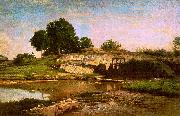 |
Charles Francois Daubigny
|
|
b Feb. 15, 1817, Paris, France
d.Feb. 19, 1878, Paris French
78, French landscape painter. He went to Italy early in life and later studied in Paris with Paul Delaroche. Although usually classed with the Barbizon school, he never lived in Barbizon. His last 30 years were spent largely in his houseboat on the Seine and the Oise, and he is best known for his pictures of the banks of those rivers. He was particularly successful in his atmospheric depiction of dawn, twilight, and moonlight. His later pictures are handled with great breadth. Monet and Boudin were especially attentive to his work. Daubigny is well represented in the Louvre, the Mesdag Museum (The Hague), the National Gallery (London), and the Metropolitan Museum. Characteristic are his Return of the Flock??Moonlight, Banks of the Oise, and Moonlight. His son Karl Pierre Daubigny, 1846?C86, painted in his father manner.
|
|
 |
Charles Dixon
|
|
1872-1934. English painter, born in Goring-on-Thames in Oxfordshire on 8 December 1872
|
|
 |
Charles Demuth
|
|
(November 8, 1883 - October 23, 1935) was an American watercolorist who turned to oils late in his career, developing a style of painting known as Precisionism.
"Search the history of American art," wrote Ken Johnson in the New York Times, "and you will discover few watercolors more beautiful than those of Charles Demuth. Combining exacting botanical observation and loosely Cubist abstraction, his watercolors of flowers, fruit and vegetables have a magical liveliness and an almost shocking sensuousness."
Demuth was a lifelong resident of Lancaster, Pennsylvania. The home he shared with his mother is now a museum of his work. He graduated from Franklin & Marshall Academy before studying at Drexel University and at Philadelphia's Pennsylvania Academy of Fine Arts.
|
|
 |
Charles Deas
|
|
1818-1867,American painter. After an unsuccessful attempt to obtain an appointment at West Point Military Academy, he turned to an artistic career. He quickly earned recognition at the annual exhibitions of the National Academy of Design, New York, to which he was elected an associate member in 1839, with subjects taken from James Fenimore Cooper, such as the Turkey Shoot (c. 1837; Richmond, VA Mus. F.A.), and from Washington Irving, The Devil and Tom Walker (1838; Richard P. W. Williams priv. col.).
|
|
 |
Charles de Lafosse
|
|
French Baroque Era Painter ,
Paris 1636/40 -1716
French painter and draughtsman. He was the most important decorative painter in France in the generation after Charles Le Brun and in this capacity contributed to many of the major official and private building projects from the 1670s to the 1710s, including the D?me des Invalides in Paris and the chapel at the ch?teau of Versailles. His colourist's temperament, his early study of the Venetian painters of the 16th century and his interest in the work of Peter Paul Rubens contributed to the triumph of the party that championed colour over line and put him in the vanguard of the new tendency in French painting in the later 17th century. His work, with its rich and changing colours, combines the strength of the 17th century with the lightness and grace of the 18th
|
|
 |
Charles de La Fosse
|
|
(June 16, 1636 - December 13, 1716), French painter, was born in Paris.
He was one of the most noted and least servile pupils of Le Brun, under whose direction he shared in the chief of the great decorative works undertaken in the reign of Louis XIV. Leaving France in 1662, he spent two years in Rome and three in Venice. The influence of his prolonged studies of Veronese is evident in his "Finding of Moses" (Louvre), an in his "Rape of Proserpine" (Louvre), which he presented to the Royal Academy as his diploma picture in 1673. He was at once named assistant professor, and in 1674 the full responsibilities of the office devolved on him, but his engagements did not prevent his accepting in 1689 the invitation of Lord Montagu to decorate Montagu House.
He visited London twice, remaining on the second occasionetogether with Rousseau and Monnoyer more than two years. William III vainly strove to detain him in England by the proposal that he should decorate Hampton Court, for Le Brun was dead, and Mansart pressed La Fosse to return to Paris to take in hand the cupola of Les Invalides. The decorations of Montagu House are destroyed, those of Versailles are restored, and the dome of the Invalides (engraved, Picart and Cochin) is now the only work existing which gives a full measure of his talent. During his latter years La Fosse executed many other important decorations in public buildings and private houses, notably in that of Crozat, under whose roof he died on 13 December 1716.
This article incorporates text from a publication now in the public domain: Chisholm, Hugh, ed (1911). Encyclopædia Britannica (11th ed.). Cambridge University Press.
|
|
|
|
 |
charles de brosses
|
|
(1709-77). President of the Parlement de Dijon, friend of the philosophes, and in Diderot's words ??une petite t??te gaie, ironique et satiriquee. His learned publications include important work on the origins of language (Traite de la formation m??canique des langues, 1765) and on primitive religion (Du culte des dieux fetiches, 1760). His Lettres familieres crites d Italie en 1739 et 1740, published posthumously in 1799 and much loved by Stendhal, offer a model of personal travel writing, in which detailed accounts of art works and monuments, not always complimentary, or a careful description of Vesuvius, addressed to Buffon, are interspersed with sprightly, enthusiastic accounts of the peculiarities and the aesthetic and sensual pleasures of life in Italy.
|
|
 |
Charles Dauphin
|
|
Charles Claude Dauphin or Dofin, called in Italian Delfino, a French painter of historical subjects and portraits, was the son of Olivier Dauphin. He went to Turin about the year 1664, and worked there for the Prince of Carignano. He was also employed for the churches, but his works are in no great estimation, abounding as they do with the most ridiculous absurdities. In the church of San Carlo is an altar-piece by him, described by Lanzi as a most ludicrous composition. He died in 1677.
|
|
|
|
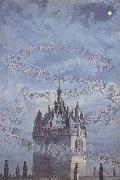 |
Charles Altamont Doyle
|
|
1832-1893
was a Victorian artist. He was the brother of the artist Richard Doyle, and the son of the artist John Doyle. Although the family was Irish, Doyle was born and raised in England. In 1849 he moved to Edinburgh where he met Mary Foley. They were married on 31 July 1855. Their children included Arthur Conan Doyle, creator of Sherlock Holmes, John Francis Innes Hay Doyle (known as Innes or Duff), and Jane Adelaide Rose Foley n??e Doyle (known as Ida). Doyle was not as successful an artist as he wished, and suffered depression and alcoholism. His paintings, which were generally of fairies, such as "A Dance Around The Moon", or similar fantasy scenes, reflected this, becoming more macabre over time. In 1881 Doyle was committed to a nursing home specialising in alcoholism. While there, his depression grew worse, and he began suffering epileptic seizures. Following a violent escape attempt he was sent to Sunnyside, Montrose Royal Lunatic Asylum, where he continued to paint. He died in Crighton Royal Institution in 1893.
|
|
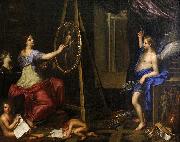 |
Charles Alphonse du Fresnoy
|
|
(1611C1665), French painter and writer on his art, was born in Paris, son of an apothecary.
He was destined for the medical profession, and well educated in Latin and Greek; but, having a natural propensity for the fine arts, he would not apply to his intended vocation, and was allowed to learn the rudiments of design under Perrier and Vouet. At the age of twenty-one he went off to Rome, with no resources; he drew ruins and architectural subjects.
After two years thus spent he re-encountered his old fellow-student Pierre Mignard, and by his aid obtained some amelioration of his professional prospects. He studied Raphael and the antique, went in 1633 to Venice, and in 1656 returned to France. During two years he was now employed in painting altar-pieces in the château du Raincy, landscapes, etc. His death was caused by an attack of apoplexy followed by palsy; he expired at Villiers-le-Bel, near Paris. He never married.
His pictorial works are few; they are correct in drawing, with something of the Caracci in design, and of Titian in colouring, but wanting fire and expression, and insufficient to keep his name in any eminent repute.
He is remembered now almost entirely as a writer rather than painter. His Latin poem, De arte graphica, was written during his Italian sojourn, and embodied his observations on the art of painting; it may be termed a critical treatise on the practice of the art, with general advice to students. The precepts are sound according to the standard of his time; the poetical merits slender enough. The Latin style is formed chiefly on Lucretius and Horace.
|
|
 |
Cesare da Sesto
|
|
Italian High Renaissance Painter, 1477-1523, He was an Italian painter of the Renaissance active in Milan and elsewhere in Italy. He was born in Sesto Calende, Lombardy. He is considered one of the Leonardeschi or artists influenced by Leonardo da Vinci, such as Bernardino Luini and Marco D'Oggione. He may have trained or worked with Baldassare Peruzzi in Rome in 1505. Of this period, a lunette in Sant'Onofrio and some paintings in Campagnano Romano are attributed to him. From 1514 he soujourned in Naples for six years. In 1515 he finished a monumental polyptych for the Abbey of Santissima Trinita at Cava de' Tirreni. Back in Milan, he executed a Baptism of Christ, in collaboration with Bernardino Bernazzano (now lost) and a Salome, acquired by Rudolf II and now at the Kunsthistorisches Museum of Vienna.
|
|
|
|
 |
Caspar David Friedrich
|
|
1774-1840 Caspar David Friedrich Locations German painter, studied art at Copenhagen, and in 1798 settled in Dresden. Friedrich painted chiefly landscapes and seascapes, with and without figures, architectural pictures, including a few of Dresden, and some religious subjects. Religious feeling and symbolism permeate his œuvre, of which the seascape with figures, Die Lebensstufen, is a characteristic example. He possessed considerable power to convey mood in landscape. Almost forgotten in the 19th c. and early 20th c., interest in his work increased considerably in the mid-20th c. He is hardly represented in Britain, but an exhibition of 112 of his pictures at the Tate Gallery in 1972 attracted much attention. F. G. Kersting was a friend of Friedrich.
|
|
|
|
 |
Carlos de Haes
|
|
Spanish
1826-1898
Carlos de Haes Galleries
Spanish painter of Belgian birth. In 1835 he moved with his parents to M?laga, where he studied under the court portrait painter and miniature painter Luis de la Cruz y R?os (1776-1853). In 1850 he returned to Belgium and studied with the landscape painter Joseph Quineaux (1822-95). During his studies there and on his travels in France, Germany and Holland, he became acquainted with contemporary Realist trends. He returned to Spain in 1855, becoming a naturalized Spaniard, and the following year he exhibited numerous landscapes at the Exposici?n Nacional, Madrid, to much acclaim. In 1857 he won the competition for the fourth chair of landscape painting at the Escuela de Bellas Artes in Madrid with View of the Royal Palace from the Casa de Campo (1857; Madrid, Real Acad. S Fernando), a work showing characteristics of the Barbizon and Fontainebleau landscape schools. In 1860 he was elected Acad?mico de m?rito at the Real Academia de S Fernando in Madrid. By 1861 he was officiating and drawing up the regulations for the landscape competitions for aspiring pensionnaires. Consequently plein-air works came to be required in place of the previous tradition of submitting historical landscapes executed in the studio, a practice that discouraged the study of nature. De Haes suggested that only final corrections should be made in the studio, an attitude that indicates his timid initiation and acceptance of Realist trends.
|
|
 |
Carlo Dolci
|
|
Italian Baroque Era Painter, 1616-ca.1686
was an Italian painter of the Baroque period, active mainly in Florence, known for highly finished religious pictures, often repeated in many versions. He was born in Florence, on his mother's side the grandson of a painter. Although he was precocious and apprenticed at a young age to Jacopo Vignali, Dolci was not prolific. "He would take weeks over a single foot", according to his biographer Baldinucci. His painstaking technique made him unsuited for large-scale fresco painting. He painted chiefly sacred subjects, and his works are generally small in scale, although he made a few life-size pictures. He often repeated the same composition in several versions, and his daughter, Agnese Dolci, also made excellent copies of his works. Dolci was known for his piety. It is said that every year during Passion Week he painted a half-figure of the Saviour wearing the Crown of Thorns. In 1682, when he saw Giordano, nicknamed "fa presto" (quick worker), paint more in five hours than he could have completed in months,
|
|
 |
Carlo Dolci
|
|
1616-1686
Italian
Carlo Dolci Locations
Italian painter. The major Florentine painter of the 17th century, he enjoyed an international reputation in his own lifetime. He was a gifted portrait painter and painted a number of large altarpieces, but his reputation is largely based on his half-length, single-figure paintings, characterized by their intense religiosity and meticulous technique. His mature style was complex and sophisticated. Intended for cultivated and aristocratic circles, his was never a popular art in any sense. Baldinucci described the painter tormented fantasy and dark fantasms, and his disturbed personality is evident throughout his work after the later 1640s.
|
|
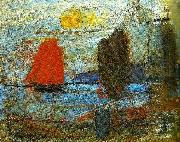 |
carl kylberg
|
|
Carl Oscar Kylberg, född 23 september 1878 på Vasängen i Fridene församling, död 6 januari 1952 i Stockholm, svensk konstnär och representant för Göteborgskoloristerna.
Carl Kylberg var son till kontorschef Gustaf Kylberg och friherrinnan Eleonora von Essen och storebror till konstnären Erik Kylberg. Hans fastrar och farbror var konstnärerna Regina Kylberg-Bobeck, Marina Kylberg och Hjalmar Kylberg. Farfadern Lars Wilhelm Kylberg var konstnär vid sidan av lantbruket på familjegodset Såtenäs i Västergötland.
Kylberg studerade först vid tekniska skolan i Stockholm och i Berlin för att bli arkitekt men övergick till måleri omkring 1900. Han studerade under en tid vid Valand i Göteborg som elev till Carl Wilhelmson. Hans verk kännetecknas ofta av ett glödande oljemåleri med starka färger och han avbildade ofta landskap och figurkompositioner på ett avskalat man??r. Under senare delen av sitt konstnärskap skapade han en mängd religiösa motiv.
Kring 1930-talet fick han sitt genombrott och han kom att ställa ut, förutom i Sverige även i Köpenhamn, Paris, London, Budapest och i USA men hans måleri var för många provocerande och 1938 gick regeringen in och stoppade ett köp av målningen Uppbrottet för Nationalmuseum i Stockholm.
En av hans mest välkända målningar är Hemkomsten från 1938 som hänger på Göteborgs konstmuseum och som föreställer ett skepp i silhuett mot en nästan brinnande gul himmel och ett rödfärgat hav. Denna målning förevigades också 1978 på ett svenskt frimärke av valören 90 öre.
Sedan 1980-talet har många av hans tavlor sålts för rekordpriser vid olika internationella konstauktioner.
|
|
|
|
 |
Carl d Unker
|
|
(3 February 1828 - 23 June 1866)was a Swedish artist. He was mostly known as a socially oriented genre painter whose works were contemporary subjects of his time, like waiting rooms at railway stations, and scenes from pawnshops for example.
D'Unkers father was a Norwegian military, his mother Swedish. He began his career as a military and had served at the Svea Life Guards for a short time, when he in 1848 volunteered in the First Schleswig War 1848-1849. Shortly after his return to Sweden he abandoned his military path and went to the arts. He moved to Desseldorf to study painting, there he got married to a wealthy Russian woman and could live a carefree life financially. He became a very popular artist on the continent. From 1861 he suffered from sickness in his right arm so he had to paint with his left arm. He made a brief visit to Sweden in 1865, and was appointed professor by Swedish king Charles XV. The following year he died.
|
|
|
|
|
|
|
|
|
| Wholesale China Oil Painting Wholesale Oil Painting China Xiamen Portrait Reproduction on canvas Chinese Oil Painting Wholesale USA Oil Painting |
|
|
|
|
|